Remote Mapping of Bedrock for Future Cosmogenic Nuclide Exposure Dating Studies in Unvisited Areas of Antarctica
Abstract
1. Introduction and Rationale
- (i)
- Obtain spectral reflectance measurements from previously collected rock samples from Mt Murphy to provide ground truth for satellite-based spectral mapping results.
- (ii)
- Investigate the capabilities of ASTER and WV-3 imagery for spectral geological analysis, with focus on specific areas of Mt Murphy.
- (iii)
- Assess supervised classification techniques for felsic-mafic rock separation at Mt Murphy using endmembers extracted from the imagery and from laboratory spectra.
- (iv)
- Produce a revised felsic-mafic geological map of Mt Murphy through integration of supervised classification, manual mapping techniques and existing ground truth.
2. Background
2.1. Remotely Sensed Datasets
2.2. Geology of Mount Murphy
2.3. Reference Geological Framework
3. Methods
3.1. Reflectance Spectroscopy of Mount Murphy Rock Samples
3.2. Multispectral Image Pre-Processing
3.3. Spectral Mapping and Classification Methods
4. Results
4.1. Mount Murphy Reflectance Spectroscopic Analysis
Results of Convolving Mt Murphy Rock Spectra
- (i)
- Spectral discrimination of granitic rock from mafic rock is achievable due to the high albedo of granitoids and the Al-OH mineral absorption feature at 2.2 µm, associated with muscovite.
- (ii)
- Gneiss can be detected using its increased reflectance at 1.2–1.8 μm wavelengths, associated with increased Fe2+ absorption (produced by the presence of biotite) and a broadband Fe/Mg-OH absorption feature at 2.33 μm, which implies the presence of chlorite and hornblende (both minerals are common in gneissic rocks).
- (iii)
- Basalt has low reflectance in general, but weathered basalt exhibits raised reflectance at 0.5–0.7 μm associated with increased Fe3+, and so can be distinguished from fresh/polished basalt.
- (iv)
- Combined mapping of Fe3+ at VNIR wavelengths and detection of Fe-rich smectite (nontronite) ~2.29 µm as a broadband Fe/Mg-OH absorption feature provide a basis for successful differentiation of basalt and fragmental hydrovolcanic rock.
4.2. Mount Murphy Spectral Mapping Case Studies
4.2.1. Case Study 1: Kay Peak and Granitoid Outcrop
4.2.2. Case Study 2: Turtle Rock, Icefall Nunatak and Notebook Cliffs
4.3. Supervised Felsic-Mafic Classification
5. Discussion
5.1. Assessment of Mapping and Supervised Classification Performance
5.2. Revised Geological Map of Mount Murphy
5.3. Implications for Future Cosmogenic Nuclide Sampling Campaigns
5.4. Study Considerations and Future Work
- WV-3 VNIR and SWIR datasets were not acquired simultaneously, precluding combined spectral analysis from band ratios and PCA and limiting the use of the SAM classifier to either VNIR or SWIR wavelengths for WV-3 imagery. The use of only part of the VNIR-SWIR spectral profile negatively impacts automatic differentiation of basalt and hydrovolcanic rock, likely contributing to cases of misclassification of these two endmembers.
- ASTER 07XT imagery was supplied with a pre-applied atmospheric correction using a radiative transfer model, whilst WV-3 data were corrected to top-of-atmosphere (TOA) reflectance. Supervised classification of ASTER imagery yielded less consistent results than WV-3, perhaps due to WV-3’s superior spatial resolution, but potentially also due to artefacts introduced to ASTER imagery during atmospheric correction.
- We found ASTER TIR imagery had a poor signal-to-noise ratio at very high latitudes, and rock outcrops are often too small to be captured at the spatial resolution of this sensor (90 metres per pixel), so we could not use ASTER TIR imagery to directly detect quartz. Instead, albedo and the Al-OH absorption feature associated with the presence of muscovite served as proxies for distinguishing silica-rich and silica-poor rock.
- A new VNIR-SWIR hyperspectral sensor—Environmental Mapping and Analysis Program (EnMAP)—with medium spatial resolution (30 metres per pixel) has been launched since we acquired imagery for this study. EnMAP possesses much improved SNR relative to older hyperspectral sensors [61] so has the potential to resolve ambiguities classifying primary muscovites in granites from Al-rich clay diamict.
- Illumination differences due to low sun angles and the steep topography of Mt Murphy, particularly of shaded slopes, impacted spectral shape and therefore SAM classification. SAM addresses topographic induced differences in albedo, but shade dampens the reflectance signal and thus suppresses the true spectral shape of the rock being classified.
- Where possible, use simultaneously acquired WV-3 VNIR and WV-3 SWIR datasets. For Antarctica, this requires specific joint VNIR-SWIR tasking requests, as WV-3 SWIR is not readily available to download from Digital Globe archives at high latitudes.
- Use L1T (Precision Terrain Corrected Registered At-Sensor Radiance) ASTER data and correct manually to top-of-atmosphere (TOA) reflectance for consistency with WV-3 image analysis. This may improve spectral classification (SAM) results using ASTER imagery.
- Future mapping would benefit from complementing the use of multispectral ASTER and Worldview-3 imagery with the new ENMAP hyperspectral sensor, especially to resolve ambiguities in mapping granitic bedrock and Al-rich clays. Resampling of the WV-3 imagery to the 30-metre spatial resolution of EnMAP would be a useful starting point for testing the effectiveness of this approach.
- Perform additional mineral analyses to better understand and distinguish the mineral composition of our samples and compare these results to petrography and spectral studies already undertaken.
6. Conclusions
- There are four spectrally distinguishable lithologic groups at Mt Murphy: granites, gneisses, basalts, and fragmental hydrovolcanic rocks. A comparison of spectral profiles of fresh, polished, and weathered surfaces indicates rock surfaces that are glacially polished are spectrally similar to fresh rock surfaces.
- Spectral classification performs well for identifying and separating silica-rich rock at the mixed felsic-mafic Kay Peak study area, and for classifying mafic outcrops to the southwest of Mt Murphy (Turtle Rock, Icefall Nunatak, Notebook Cliffs). More ambiguous spectral classification results from other parts of Mt Murphy can be resolved by using spectral mapping techniques to identify areas of Al-OH absorption and high albedo, as well as photo geological interpretation of WV-3 panchromatic imagery.
- Separation of granite and biotite gneiss lithologies from mafic lithologies at VNIR-SWIR wavelengths can serve as a proxy for silica content. Strong Al-OH absorption and high albedo (average reflectance across the VIS-SWIR range) are useful for detecting granite, while Fe2+ and Fe/Mg-OH absorption features are useful for detecting biotite-rich gneiss, demonstrating that separation of these lithologies at VNIR-SWIR wavelengths can serve as a proxy for silica content. This is useful because the ASTER TIR sensor can directly detect silica, but its spatial resolution is too coarse to identify silica at many rock outcrops, and its signal-to-noise ratio is often poor at high polar latitudes.
- Altered fragmental volcanic rock can be differentiated from basalt using remote sensing due to the increased Fe3+ and Fe/Mg-OH absorption signature of Fe-rich smectite that is present in fragmental hydrovolcanic rock but absent in basaltic rocks.
- Differentiation of felsic and mafic rock outcrops can be achieved with broadband WV-3 SWIR imagery, and similar (though coarser) results can be achieved with medium-resolution ASTER SWIR imagery.
Supplementary Materials
Author Contributions
Funding
Data Availability Statement
Acknowledgments
Conflicts of Interest
References
- Stone, J.O.; Balco, G.A.; Sugden, D.E.; Caffee, M.W.; Sass, L.C.; Cowdery, S.G.; Siddoway, C. Holocene Deglaciation of Marie Byrd Land, West Antarctica. Science 2003, 299, 99–102. [Google Scholar] [CrossRef] [PubMed]
- Johnson, J.S.; Roberts, S.J.; Rood, D.H.; Pollard, D.; Schaefer, J.M.; Whitehouse, P.L.; Ireland, L.C.; Lamp, J.L.; Goehring, B.M.; Rand, C.; et al. Deglaciation of Pope Glacier Implies Widespread Early Holocene Ice Sheet Thinning in the Amundsen Sea Sector of Antarctica. Earth Planet. Sci. Lett. 2020, 548, 116–501. [Google Scholar] [CrossRef]
- Balco, G. Contributions and Unrealized Potential Contributions of Cosmogenic-Nuclide Exposure Dating to Glacier Chronology, 1990–2010. Quat. Sci. Rev. 2011, 30, 3–27. [Google Scholar] [CrossRef]
- Pigati, J.S.; Lifton, N.A.; Timothy Jull, A.J.; Quade, J. Extraction of in Situ Cosmogenic 14C from Olivine. Radiocarbon 2010, 52, 1244–1260. [Google Scholar] [CrossRef]
- Bergelin, M.; Balco, G.; Corbett, L.B.; Bierman, P.R. Production Rate Calibration for Cosmogenic 10Be in Pyroxene by Applying a Rapid Fusion Method to 10Be-Saturated Samples from the Transantarctic Mountains, Antarctica. Geochronology 2024, 6, 491–502. [Google Scholar] [CrossRef]
- Kennicutt, M.C.; Kim, Y.D.; Rogan-Finnemore, M.; Anandakrishnan, S.; Chown, S.L.; Colwell, S.; Cowan, D.; Escutia, C.; Frenot, Y.; Hall, J.; et al. Delivering 21st Century Antarctic and Southern Ocean Science. Antarct. Sci. 2016, 28, 407–423. [Google Scholar] [CrossRef]
- Drury, S.A. Image Interpretation in Geology, 3rd ed.; Nelson Thornes: Cheltenham, UK, 2001; ISBN 9780748764990. [Google Scholar]
- Jawak, S.D.; Luis, A.J. A Spectral Index Ratio-Based Antarctic Land-Cover Mapping Using Hyperspatial 8-Band WorldView-2 Imagery. Polar Sci. 2013, 7, 18–38. [Google Scholar] [CrossRef]
- Haselwimmer, C.E.; Riley, T.R.; Liu, J.G. Assessing the Potential of Multispectral Remote Sensing for Lithological Mapping on the Antarctic Peninsula: Case Study from Eastern Adelaide Island, Graham Land. Antarct. Sci. 2010, 22, 299–318. [Google Scholar] [CrossRef]
- Haselwimmer, C.E.; Riley, T.R.; Liu, J.G. Lithologic Mapping in the Oscar II Coast Area, Graham Land, Antarctic Peninsula Using ASTER Data. Int. J. Remote Sens. 2011, 32, 2013–2035. [Google Scholar] [CrossRef]
- Kruse, F.A.; Baugh, W.M.; Perry, S.L. Validation of DigitalGlobe WorldView-3 Earth Imaging Satellite Shortwave Infrared Bands for Mineral Mapping. J. Appl. Remote Sens. 2015, 9, 096044. [Google Scholar] [CrossRef]
- Wilch, T.I.; McIntosh, W.C.; Panter, K.S. Marie Byrd Land and Ellsworth Land: Volcanology. In Volcanism in Antarctica: 200 Million Years of Subduction, Rifting and Continental Break-Up; The Geological Society of London: London, UK, 2021; Volume 55, ISBN 0000000329. [Google Scholar] [CrossRef]
- LeMasurier, W.E.; Harwood, D.M.; Rex, D.C. Geology of Mount Murphy Volcano: An 8-m.y. History of Interaction between a Rift Volcano and the West Antarctic Ice Sheet. Geol. Soc. Am. Bull. 1994, 106, 265–280. [Google Scholar] [CrossRef]
- Pankhurst, R.J.; Weaver, S.D.; Bradshaw, J.D.; Storey, B.C.; Ireland, T.R. Geochronology and Geochemistry of Pre-Jurassic Superterranes in Marie Byrd Land, Antarctica. J. Geophys. Res. 1998, 103, 2529–2547. [Google Scholar] [CrossRef]
- Smellie, J.L. Lithofacies Architecture and Construction of Volcanoes Erupted in Englacial Lakes: Icefall Nunatak, Mount Murphy, Eastern Marie Byrd Land, Antarctica. In Volcaniclastic Sedimentation in Lacustrine Settings; John Wiley & Sons, Ltd.: Hoboken, NJ, USA, 2001; pp. 7–34. ISBN 9781444304251. [Google Scholar]
- Wilch, T.I.; McIntosh, W.C. Lithofacies Analysis and 40Ar/39Ar Geochronology of Ice-Volcano Interactions at Mt. Murphy and the Crary Mountains, Marie Byrd Land, Antarctica. Geol. Soc. Spec. Publ. 2002, 202, 237–253. [Google Scholar] [CrossRef]
- Howat, I.M.; Porter, C.; Smith, B.E.; Noh, M.-J.; Morin, P. The Reference Elevation Model of Antarctica. Cryosphere 2019, 13, 665–674. [Google Scholar] [CrossRef]
- Dorschel, B.; Hehemann, L.; Viquerat, S.; Warnke, F.; Dreutter, S.; Tenberge, Y.S.; Accettella, D.; An, L.; Barrios, F.; Bazhenova, E.; et al. The International Bathymetric Chart of the Southern Ocean Version 2. Sci. Data 2022, 9, 275. [Google Scholar] [CrossRef]
- Rignot, E.; Mouginot, J.; Scheuchl, B. Antarctic Grounding Line Mapping from Differential Satellite Radar Interferometry. Geophys. Res. Lett. 2011, 38, L10504. [Google Scholar] [CrossRef]
- Burton-Johnson, A.; Black, M.; Fretwell, P.T.; Kaluza-Gilbert, J. An Automated Methodology for Differentiating Rock from Snow, Clouds and Sea in Antarctica from Landsat 8 Imagery: A New Rock Outcrop Map and Area Estimation for the Entire Antarctic Continent. The Cryosphere 2016, 10, 1665–1677. [Google Scholar] [CrossRef]
- Rowan, L.C.; Mars, J.C. Lithologic Mapping in the Mountain Pass, California Area Using Advanced Spaceborne Thermal Emission and Reflection Radiometer (ASTER) Data. Remote Sens. Environ. 2003, 84, 350–366. [Google Scholar] [CrossRef]
- Mars, J.C. Mineral and Lithologic Mapping Capability of Worldview 3 Data at Mountain Pass, California, Using True- and False-Color Composite Images, Band Ratios, and Logical Operator Algorithms. Econ. Geol. 2018, 113, 1587–1601. [Google Scholar] [CrossRef]
- Bishop, C.A.; Liu, J.G.; Mason, P.J. Hyperspectral Remote Sensing for Mineral Exploration in Pulang, Yunnan Province, China. Int. J. Remote Sens. 2011, 32, 2409–2426. [Google Scholar] [CrossRef]
- Pour, A.B.; Sekandari, M.; Rahmani, O.; Crispini, L.; Läufer, A.; Park, Y.; Kuk Hong, J.; Pradhan, B.; Hashim, M.; Shawkat Hossain, M.; et al. Identification of Phyllosilicates in the Antarctic Environment Using ASTER Satellite Data: Case Study from the Mesa Range, Campbell and Priestley Glaciers, Northern Victoria Land Identification of Phyllosilicates in the Antarctic Environmen. Remote Sens. 2021, 13, 38. [Google Scholar] [CrossRef]
- Mars, J.C.; Rowan, L.C. Regional Mapping of Phyllic- and Argillic-Altered Rocks in the Zagros Magmatic Arc, Iran, Using Advanced Spaceborne Thermal Emission and Reflection Radiometer (ASTER) Data and Logical Operator Algorithms. Geosphere 2006, 2, 161–186. [Google Scholar] [CrossRef]
- Cŕosta, A.P.; De Souza Filho, C.R.; Azevedo, F.; Brodie, C. Targeting Key Alteration Minerals in Epithermal Deposits in Patagonia, Argentina, Using ASTER Imagery and Principal Component Analysis. Int. J. Remote Sens. 2003, 24, 4233–4240. [Google Scholar] [CrossRef]
- Bedini, E. Mineral Mapping in the Kap Simpson Complex, Central East Greenland, Using HyMap and ASTER Remote Sensing Data. Adv. Space Res. 2011, 47, 60–73. [Google Scholar] [CrossRef]
- Fujisada, H.; Ono, A. Observational Performance of ASTER Instrument on EOS-AM1 Spacecraft. Adv. Space Res. 1994, 14, 147–150. [Google Scholar] [CrossRef]
- Ye, B.; Tian, S.; Ge, J.; Sun, Y. Assessment of WorldView-3 Data for Lithological Mapping. Remote Sens. 2017, 9, 1132. [Google Scholar] [CrossRef]
- Bedini, E. Application of WorldView-3 Imagery and ASTER TIR Data to Map Alteration Minerals Associated with the Rodalquilar Gold Deposits, Southeast Spain. Adv. Space Res. 2019, 63, 3346–3357. [Google Scholar] [CrossRef]
- Sun, Y.; Tian, S.; Di, B. Extracting Mineral Alteration Information Using WorldView-3 Data. Geosci. Front. 2017, 8, 1051–1062. [Google Scholar] [CrossRef]
- Jawak, S.D.; Luis, A.J.; Fretwell, P.T.; Convey, P.; Durairajan, U.A. Semiautomated Detection and Mapping of Vegetation Distribution in the Antarctic Environment Using Spatial-Spectral Characteristics of WorldView-2 Imagery. Remote Sens. 2019, 11, 1909. [Google Scholar] [CrossRef]
- Newall, J.C.H.; Dymova, T.; Serra, E.; Blomdin, R.; Fredin, O.; Glasser, N.F.; Suganuma, Y.; Harbor, J.M.; Stroeven, A.P. The Glacial Geomorphology of Western Dronning Maud Land, Antarctica. J. Maps 2020, 16, 468–478. [Google Scholar] [CrossRef]
- Ritzwoller, M.H.; Shapiro, N.M.; Levshin, A.L.; Leahy, G.M. Crustal and Upper Mantle Structure beneath Antarctica and Surrounding Oceans. J. Geophys. Res. Solid Earth 2001, 106, 30645–30670. [Google Scholar] [CrossRef]
- Jordan, T.A.; Riley, T.R.; Siddoway, C.S. The Geological History and Evolution of West Antarctica. Nat. Rev. Earth Environ. 2020, 1, 117–133. [Google Scholar] [CrossRef]
- Siddoway, C.S.; Fanning, C.M. Paleozoic Tectonism on the East Gondwana Margin: Evidence from SHRIMP U-Pb Zircon Geochronology of a Migmatite-Granite Complex in West Antarctica. Tectonophysics 2009, 477, 262–277. [Google Scholar] [CrossRef]
- LeMasurier, W. Shield Volcanoes of Marie Byrd Land, West Antarctic Rift: Oceanic Island Similarities, Continental Signature, and Tectonic Controls. Bull. Volcanol. 2013, 75, 726. [Google Scholar] [CrossRef]
- Johnson, J.S.; Bentley, M.J.; Gohl, K. First Exposure Ages from the Amundsen Sea Embayment, West Antarctica: The Late Quaternary Context for Recent Thinning of Pine Island, Smith, and Pope Glaciers. Geology 2008, 36, 223–226. [Google Scholar] [CrossRef]
- Adams, J.R.; Johnson, J.S.; Roberts, S.J.; Mason, P.J.; Nichols, K.A.; Venturelli, R.A.; Wilcken, K.; Balco, G.; Goehring, B.; Hall, B.; et al. New 10Be Exposure Ages Improve Holocene Ice Sheet Thinning History near the Grounding Line of Pope Glacier, Antarctica. The Cryosphere 2022, 16, 4887–4905. [Google Scholar] [CrossRef]
- Balco, G.; Brown, N.; Nichols, K.; Venturelli, R.A.; Adams, J.; Braddock, S.; Campbell, S.; Goehring, B.; Johnson, J.S.; Rood, D.H.; et al. Reversible Ice Sheet Thinning in the Amundsen Sea Embayment during the Late Holocene. The Cryosphere 2023, 17, 1787–1801. [Google Scholar] [CrossRef]
- Ninomiya, Y.; Fu, B.; Cudahy, T.J. Detecting Lithology with Advanced Spaceborne Thermal Emission and Reflection Radiometer (ASTER) Multispectral Thermal Infrared “Radiance-at-Sensor” Data. Remote Sens. Environ. 2005, 99, 127–139. [Google Scholar] [CrossRef]
- Hunt, G.R. Near-Infrared (1.3-2.4 Μm) Spectra of Alteration Minerals; Potential for Use in Remote Sensing. Geophysics 1979, 44, 1974–1986. [Google Scholar] [CrossRef]
- Morris, R.V.; Lauer, H.V.; Lawson, C.A.; Gibson, E.K.; Nace, G.A.; Stewart, C. Spectral and Other Physicochemical Properties of Submicron Powders of Hematite (Alpha-Fe2O3), Maghemite (Gamma-Fe2O3), Magnetite (Fe3O4), Goethite (Alpha-FeOOH) and Lepidocrocite (Gamma-FeOOH). J. Geophys. Res. 1985, 90, 3126–3144. [Google Scholar] [CrossRef]
- Zhou, K.; Wang, S. Spectral Properties of Weathered and Fresh Rock Surfaces in the Xiemisitai Metallogenic Belt, NW Xinjiang, China. Open Geosci. 2017, 9, 322–339. [Google Scholar] [CrossRef][Green Version]
- Clark, R.N.; King, T.V.V.; Klejwa, M.; Swayze, G.A. High Spectral Resolution Reflectance Spectroscopy of Minerals. J. Geophys. Res. 1990, 95, 653–665. [Google Scholar] [CrossRef]
- Waske, B.; Benediktsson, J.A.; Arnason, K.; Sveinsson, J.R. Mapping of Hyperspectral AVIRIS Data Using Machine-Learning Algorithms. Can. J. Remote Sens. 2009, 35, S106–S116. [Google Scholar] [CrossRef]
- Smellie, J.L. Basaltic Subglacial Sheet-like Sequences: Evidence for Two Types with Different Implications for the Inferred Thickness of Associated Ice. Earth-Sci. Rev. 2008, 88, 60–88. [Google Scholar] [CrossRef]
- Spectral Evolution. Available online: https://spectralevolution.com/product/psr/ (accessed on 28 November 2024).
- Menges, F. SpectraGryph-Optical Spectroscopy Software, Version 1.2.15, 2020. Available online: https://www.effemm2.de/spectragryph/ (accessed on 20 April 2024).
- Adams, J.R.; Johnson, J.S.; Roberts, S.J.; Mason, P.J.; Rood, D.H.; Ramsay, R. Laboratory Spectral Reflectance Measurements at VNIR-SWIR Wavelengths of 17 Rock Samples from Mount Murphy, West Antarctica (Version 1.0) [Data Set], NERC EDS UK Polar Data Centre. 2024. Available online: https://data.bas.ac.uk/full-record.php?id=GB/NERC/BAS/PDC/01918 (accessed on 2 March 2024).
- NASA/METI/AIST/Japan Spacesystems and U.S./Japan ASTER Science Team ASTER On-Demand L2 Surface Reflectance VNIR and SWIR Crosstalk-Corrected [AST_07XT.003]. NASA EOSDIS Land Processes Distributed Active Archive Center. Sioux Falls, South Dakota, USA. Available online: https://lpdaac.usgs.gov/products/ast_07xtv003/ (accessed on 2 March 2024).
- Kruse, F.A.; Lefkoff, A.B.; Boardman, J.W.; Heidebrecht, K.B.; Shapiro, A.T.; Barloon, P.J.; Goetz, A.F.H. The Spectral Image Processing System (SIPS)-Interactive Visualization and Analysis of Imaging Spectrometer Data. Remote Sens. Environ. 1993, 44, 145–163. [Google Scholar] [CrossRef]
- Dennison, P.E.; Halligan, K.Q.; Roberts, D.A. A Comparison of Error Metrics and Constraints for Multiple Endmember Spectral Mixture Analysis and Spectral Angle Mapper. Remote Sens. Environ. 2004, 93, 359–367. [Google Scholar] [CrossRef]
- Kokaly, R.F.; Clark, R.N.; Swayze, G.A.; Livo, K.E.; Hoefen, T.M.; Pearson, N.C.; Wise, R.A.; Benzel, W.M.; Lowers, H.A.; Driscoll, R.L.; et al. USGS Spectral Library Version 7; US Geological Survey: Reston, VA, USA, 2017. [Google Scholar]
- Bishop, J.L.; Lane, M.D.; Dyar, M.D.; Brown, A.J. Reflectance and Emission Spectroscopy Study of Four Groups of Phyllosilicates: Smectites, Kaolinite-Serpentines, Chlorites and Micas. Clay Miner. 2008, 43, 35–54. [Google Scholar] [CrossRef]
- Johnson, J.S.; Smellie, J.L. Zeolite Compositions as Proxies for Eruptive Paleoenvironment. Geochem. Geophys. Geosyst. 2007, 8, Q03009. [Google Scholar] [CrossRef]
- Bindschadler, R.; Vornberger, P.; Fleming, A.; Fox, A.; Mullins, J.; Binnie, D.; Jean, S.; Granneman, B.; Gorodetzky, D. Remote Sensing of Environment The Landsat Image Mosaic of Antarctica. Remote Sens. Environ. 2008, 112, 4214–4226. [Google Scholar] [CrossRef]
- Fretwell, P.T.; Phillips, R.A.; Brooke, M.d.L.; Fleming, A.H.; McArthur, A. Using the Unique Spectral Signature of Guano to Identify Unknown Seabird Colonies. Remote Sens. Environ. 2015, 156, 448–456. [Google Scholar] [CrossRef]
- Blard, P.H.; Farley, K.A. The Influence of Radiogenic 4He on Cosmogenic 3He Determinations in Volcanic Olivine and Pyroxene. Earth Planet. Sci. Lett. 2008, 276, 20–29. [Google Scholar] [CrossRef]
- Braddock, S.; Venturelli, R.A.; Nichols, K.; Moravec, E.; Boeckmann, G.V.; Campbell, S.; Balco, G.; Ackert, R.; Small, D.; Johnson, J.S.; et al. Lessons Learned from Shallow Subglacial Bedrock Drilling Campaigns in Antarctica. Ann. Glaciol. 2025, 65, e18. [Google Scholar] [CrossRef]
- Kruse, F.A.; Boardman, J.W.; Huntington, J.F. Comparison of Airborne Hyperspectral Data and EO-1 Hyperion for Mineral Mapping. IEEE Trans. Geosci. Remote Sens. 2003, 41, 1388–1400. [Google Scholar] [CrossRef]
- Milton, E.J.; Schaepman, M.E.; Anderson, K.; Kneubühler, M.; Fox, N. Progress in Field Spectroscopy. Remote Sens. Environ. 2009, 113, S92–S109. [Google Scholar] [CrossRef]
- Haselwimmer, C.E. Lithological Mapping on the Antarctic Peninsula Using Advanced Spaceborne Thermal Emission and Reflection Radiometer (ASTER) Data. Ph.D. Thesis, Imperial College London, London, UK, 2010. [Google Scholar]
- Kuester, M. Radiometric Use of WorldView—3 Imagery Technical Note 1 WorldView-3 Instrument WorldView-3 Relative Radiance Response. Digit. Globe 2016, 1–12. [Google Scholar]
- Thuillier, G.; Hersé, M.; Labs, D.; Foujols, T.; Peetermans, W.; Gillotay, D.; Simon, P.C.; Mandel, H. The Solar Spectral Irradiance from 200 to 2400 Nm as Measured by the SOLSPEC Spectrometer from the ATLAS and EURECA Missions. Sol. Phys. 2003, 214, 1–22. [Google Scholar] [CrossRef]
- Iwasaki, A.; Tonooka, H. Validation of a Crosstalk Correction Algorithm for ASTER/SWIR. IEEE Trans. Geosci. Remote Sens. 2005, 43, 2747–2751. [Google Scholar] [CrossRef]
- Cracknell, A.P. Review Article Synergy in Remote Sensing-What’s in a Pixel? Int. J. Remote Sens. 2010, 19, 2025–2047. [Google Scholar] [CrossRef]
- Crowley, J.K.; Brickey, D.W.; Rowan, L.C. Airborne Imaging Spectrometer Data of the Ruby Mountains, Montana: Mineral Discrimination Using Relative Absorption Band-Depth Images. Remote Sens. Environ. 1989, 29, 121–134. [Google Scholar] [CrossRef]
- Zhang, J.; Rivard, B.; Sánchez-Azofeifa, A. Spectral Unmixing of Normalized Reflectance Data for the Deconvolution of Lichen and Rock Mixtures. Remote Sens. Environ. 2005, 95, 57–66. [Google Scholar] [CrossRef]
- Campbell, I.B.; Claridge, G.G.C. Antarctica: Soils, Weathering Processes and Environment; Elsevier: Amsterdam, The Netherlands, 1987; ISBN 008086984X. [Google Scholar]
- Kanamaru, T.; Suganuma, Y.; Oiwane, H.; Miura, H.; Miura, M.; Okuno, J.; Hayakawa, H. The Weathering of Granitic Rocks in a Hyper-Arid and Hypothermal Environment: A Case Study from the Sør-Rondane Mountains, East Antarctica. Geomorphology 2018, 317, 62–74. [Google Scholar] [CrossRef]
- Salvatore, M.R.; Mustard, J.F.; Head, J.W.; Cooper, R.F.; Marchant, D.R.; Wyatt, M.B. Development of Alteration Rinds by Oxidative Weathering Processes in Beacon Valley, Antarctica, and Implications for Mars. Geochim. Cosmochim. Acta 2013, 115, 137–161. [Google Scholar] [CrossRef]
- Stroncik, N.A.; Schmincke, H.U. Palagonite—A Review. Int. J. Earth Sci. 2002, 91, 680–697. [Google Scholar] [CrossRef]
- Farrand, W.H.; Wright, S.P.; Glotch, T.D.; Schröder, C.; Sklute, E.C.; Dyar, M.D. Spectroscopic Examinations of Hydro- and Glaciovolcanic Basaltic Tuffs: Modes of Alteration and Relevance for Mars. Icarus 2018, 309, 241–259. [Google Scholar] [CrossRef]
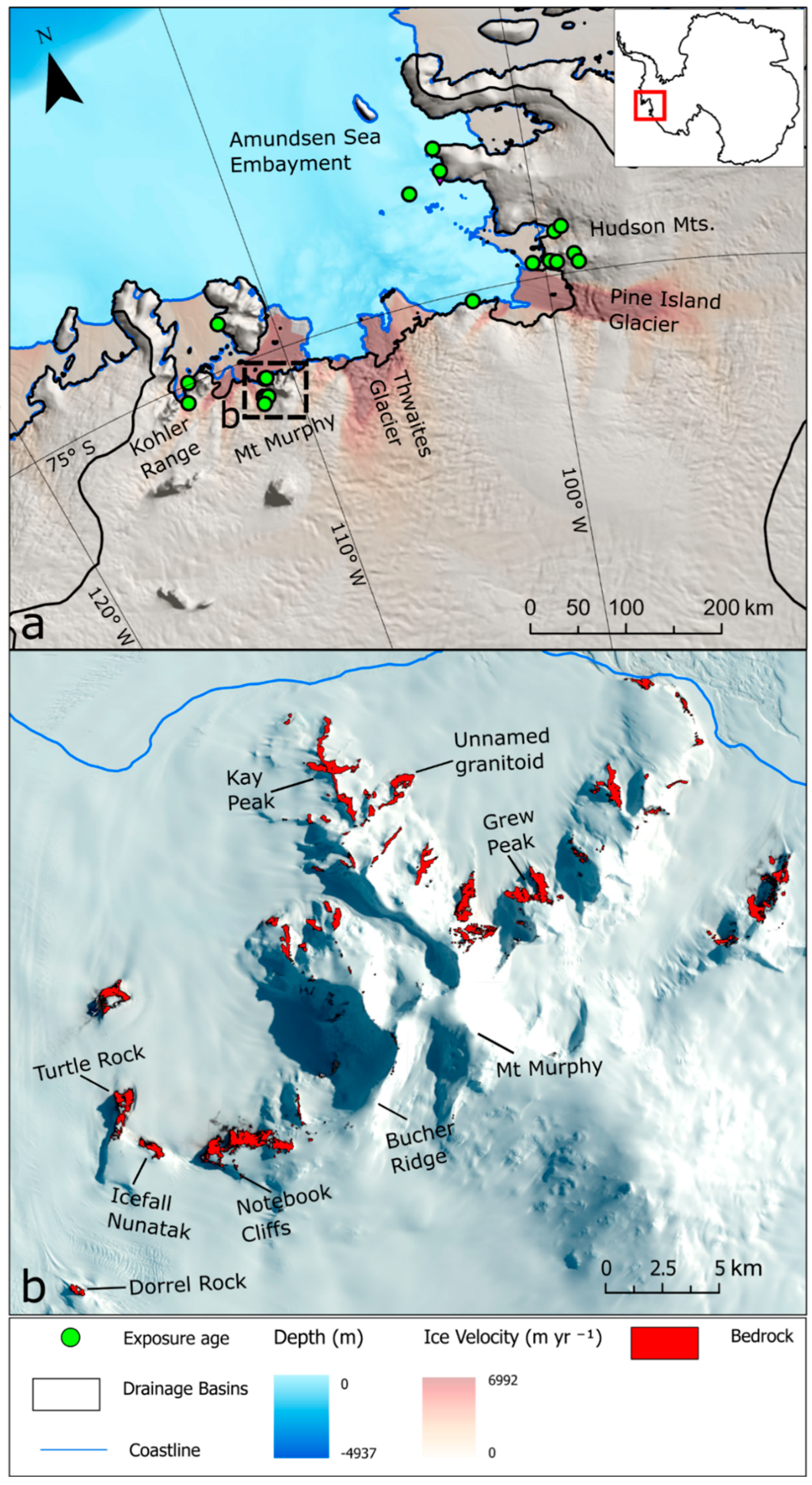


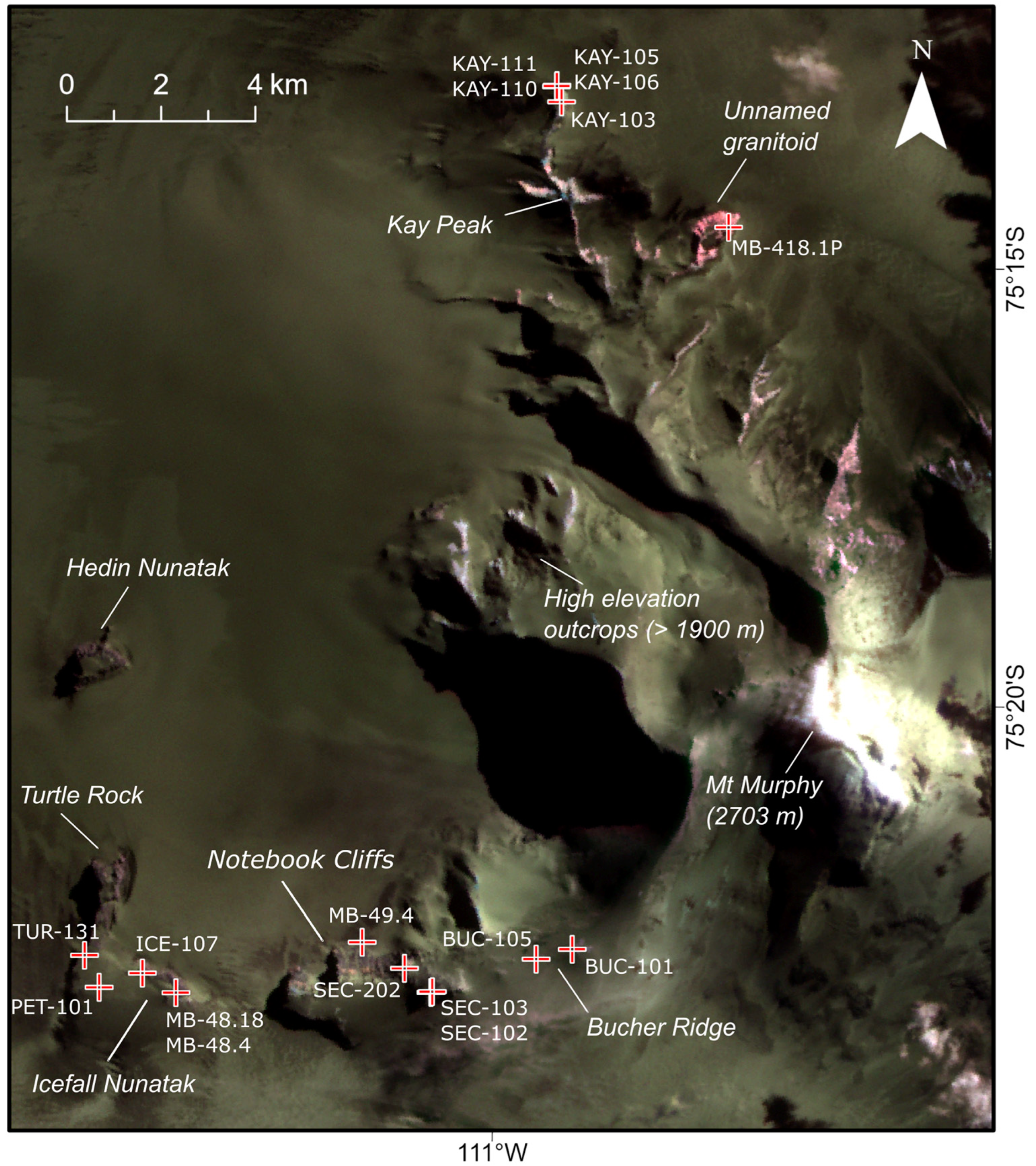
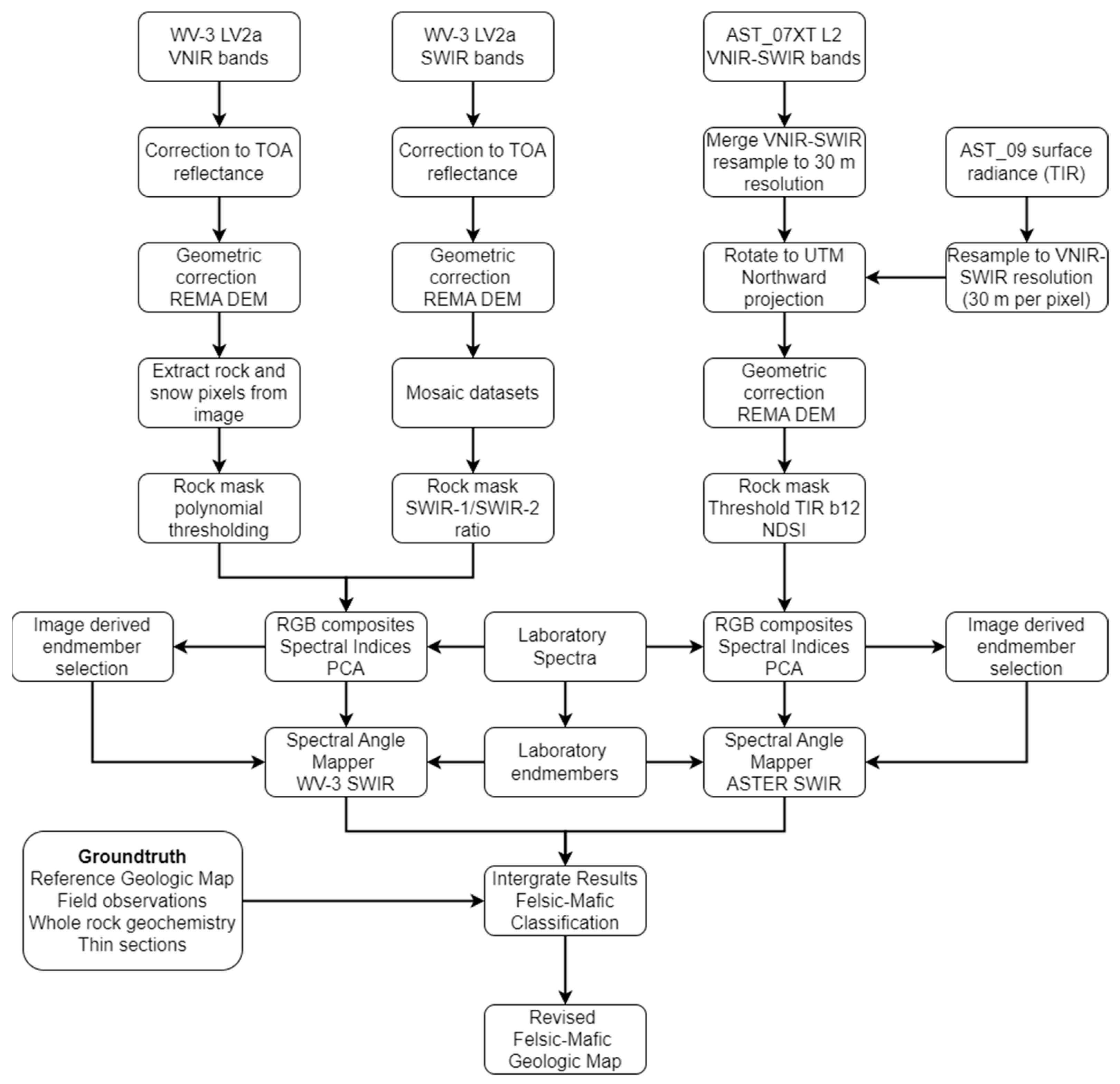

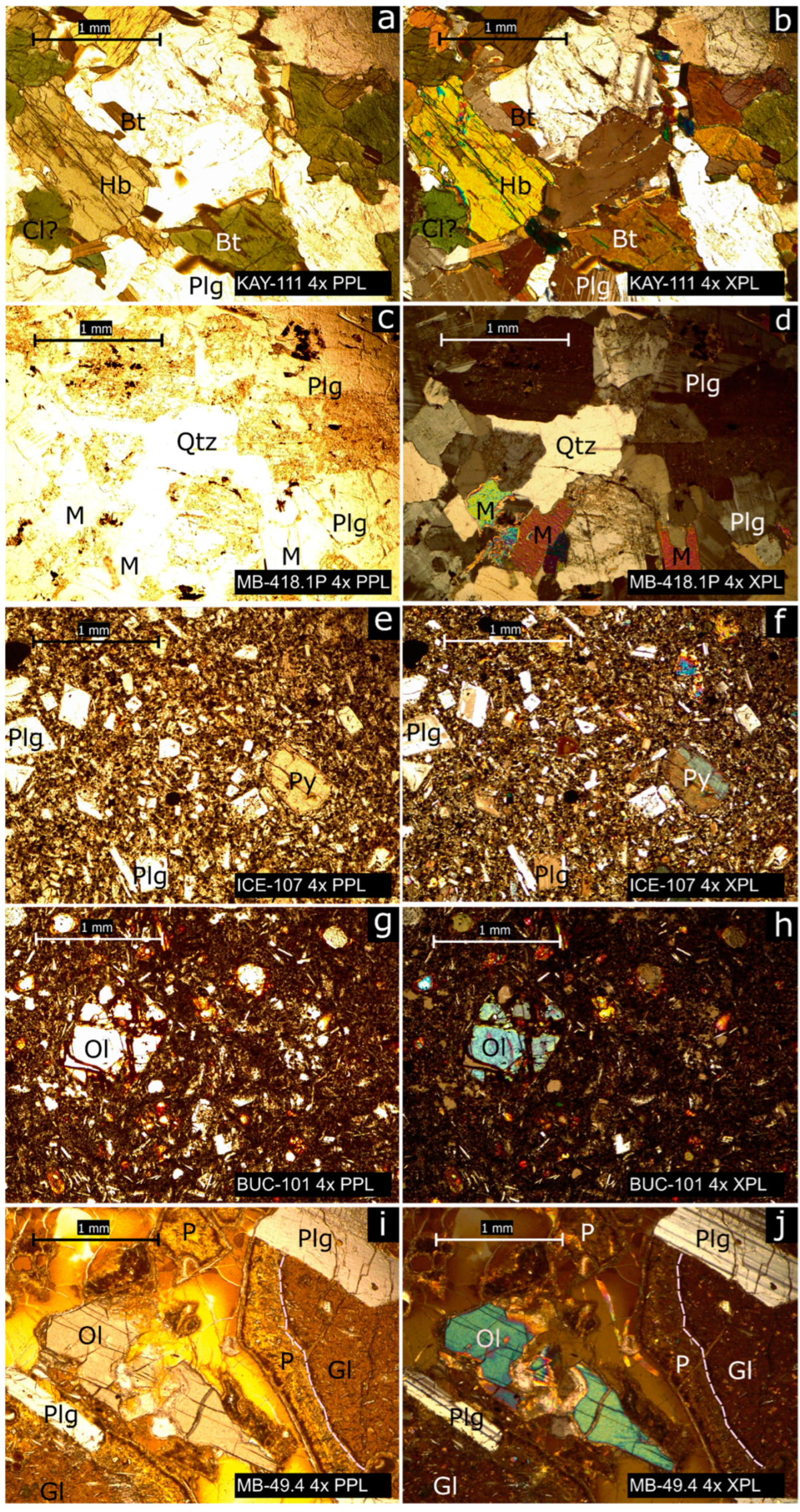

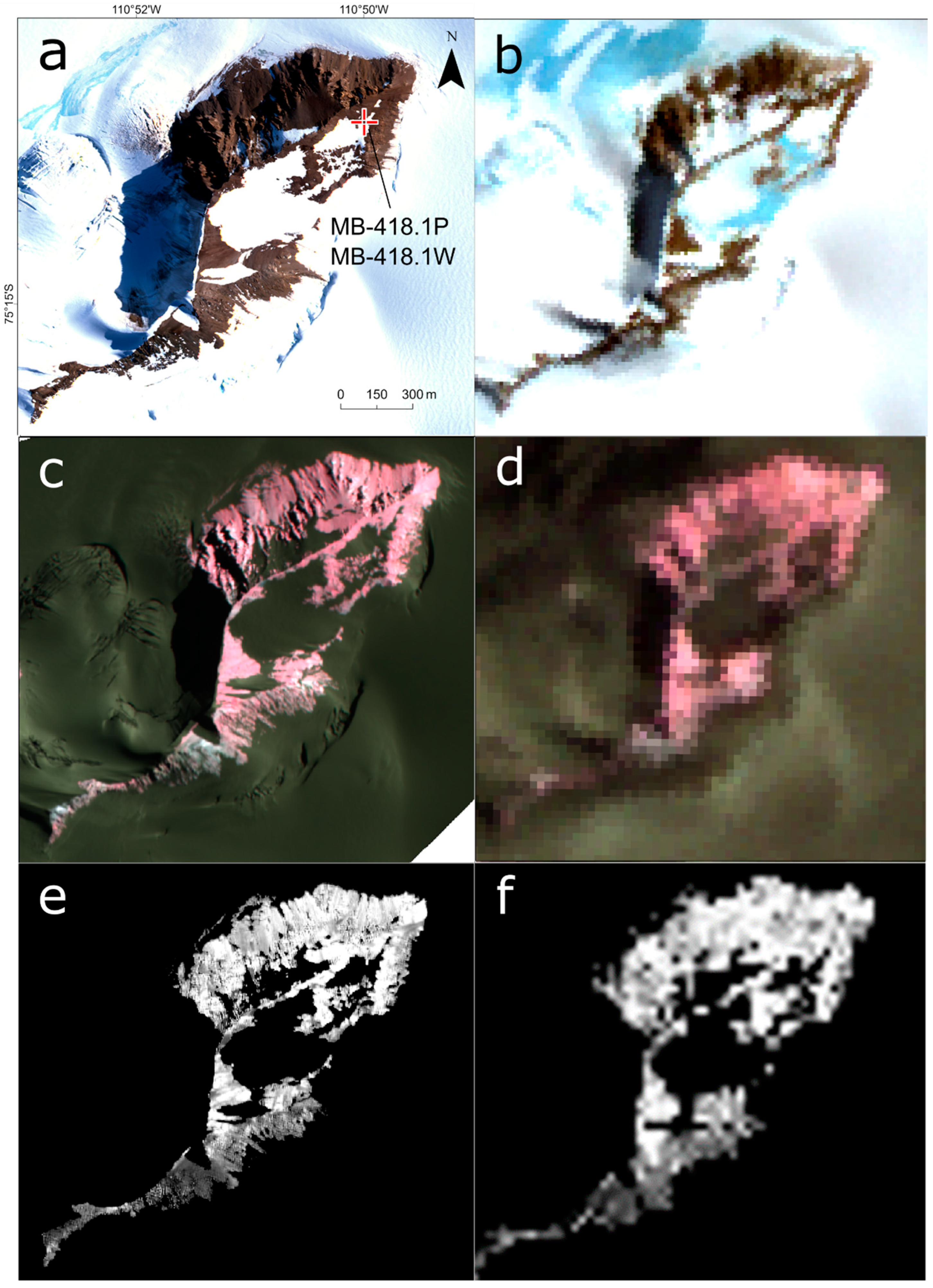

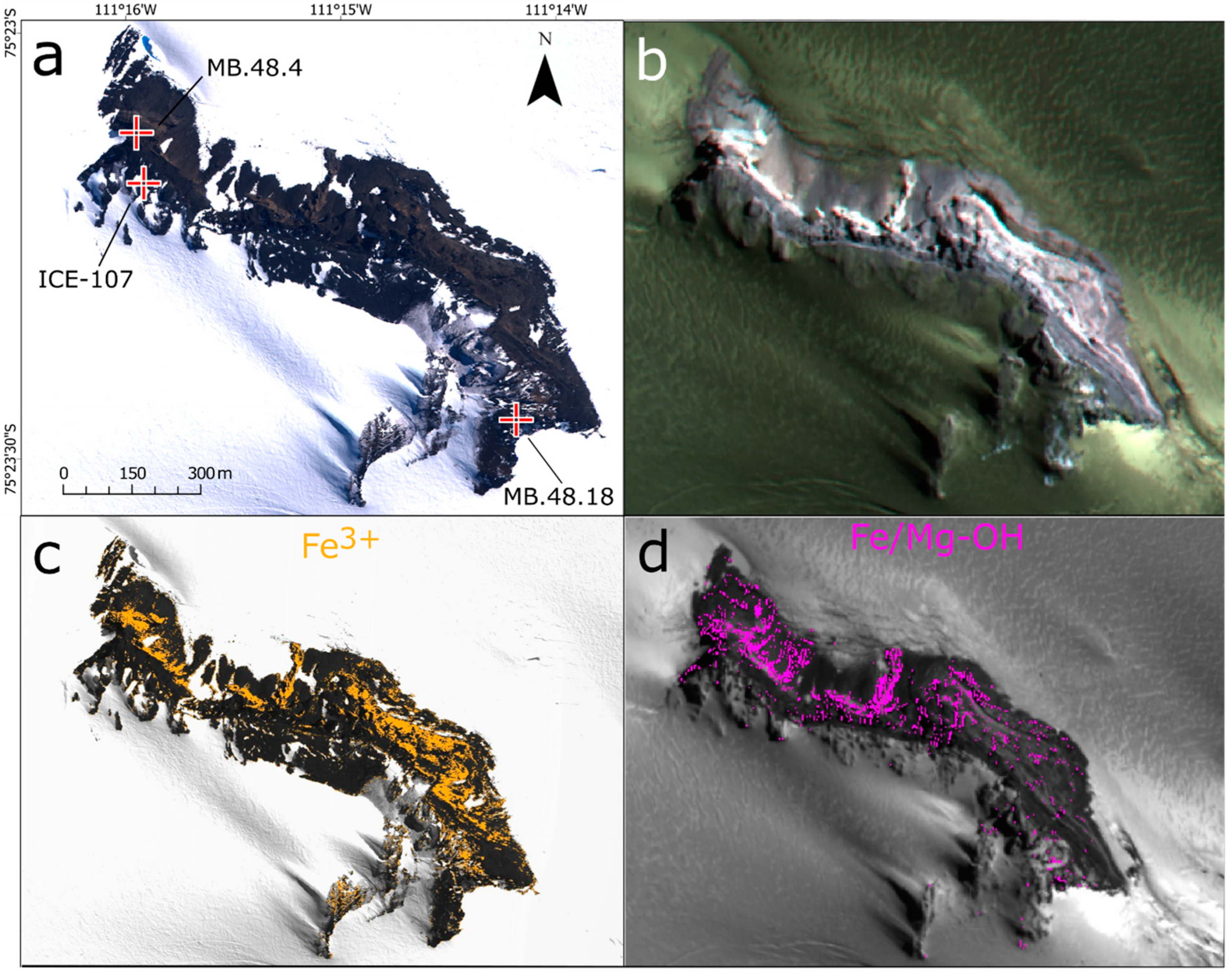
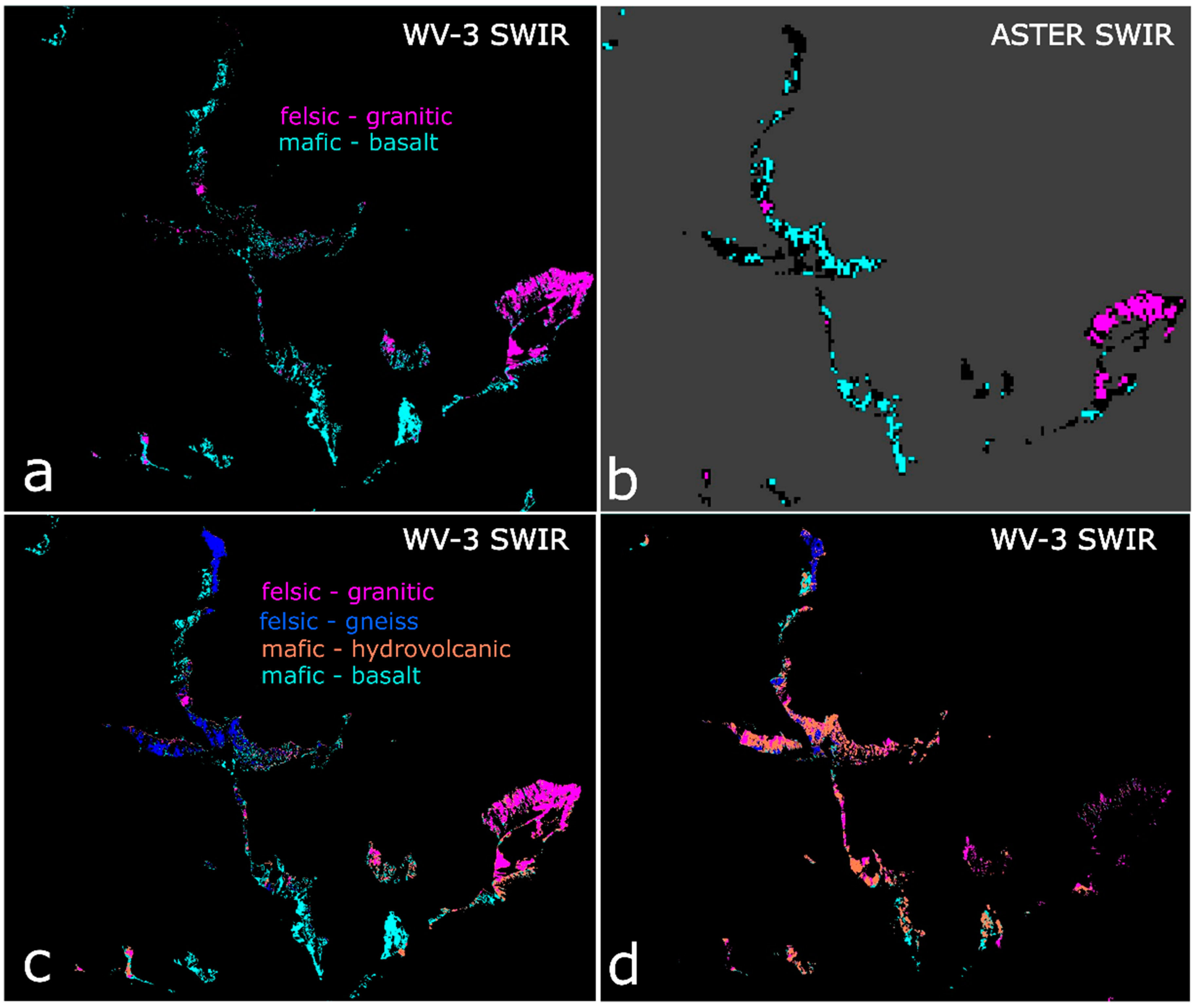
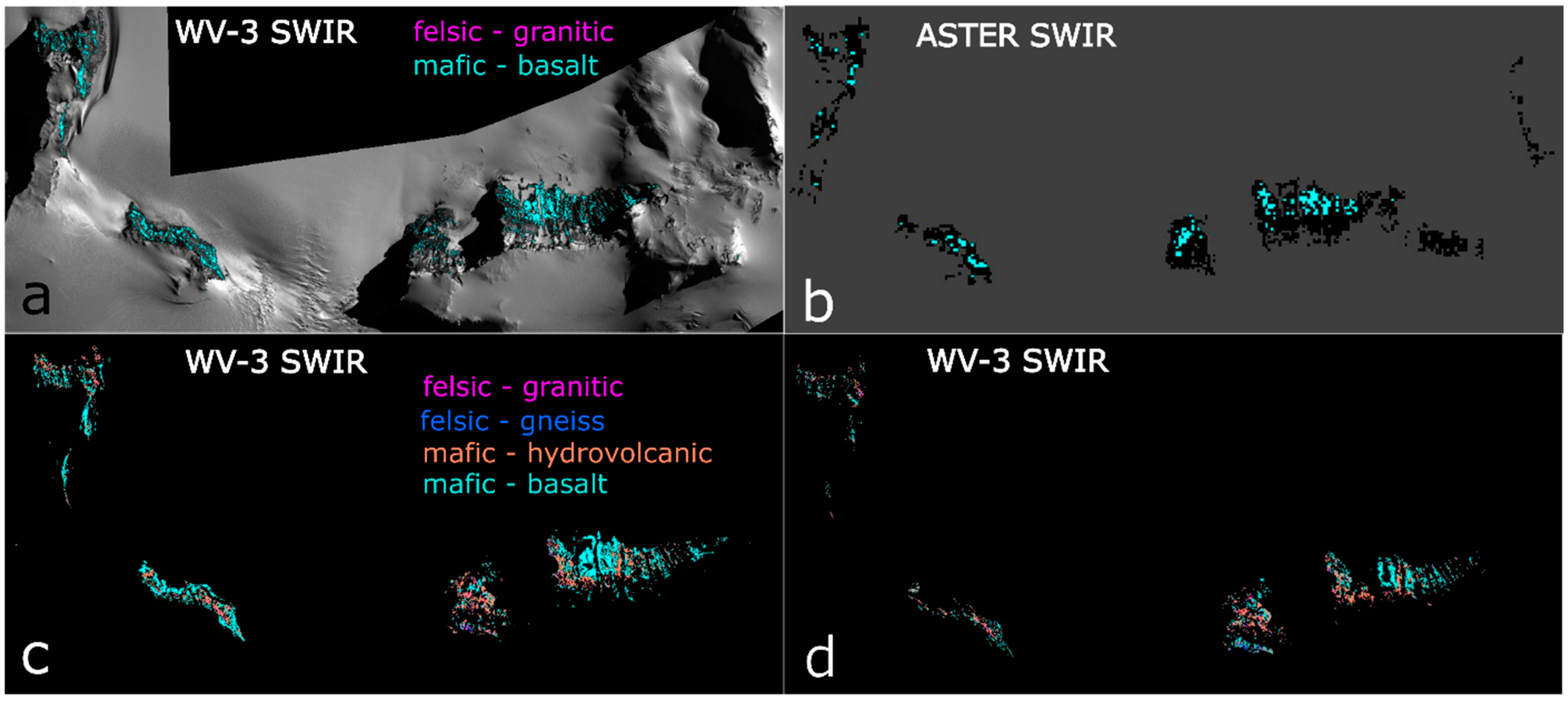


| Sub-System | Band No. | Band Name | Wavelength (μm) | Spatial Resolution (m) |
|---|---|---|---|---|
| 1 | VNIR-1 | 0.52–0.60 | 15 | |
| VNIR | 2 | VNIR-2 | 0.63–0.69 | 15 |
| 3N | VNIR-3N | 0.78–0.86 | 15 | |
| 3B | VNIR-3B | 0.78–0.86 | 15 | |
| 4 | SWIR-1 | 1.60–1.70 | 30 | |
| 5 | SWIR-2 | 2.15–2.19 | 30 | |
| SWIR | 6 | SWIR-3 | 2.19–2.23 | 30 |
| 7 | SWIR-4 | 2.24–2.29 | 30 | |
| 8 | SWIR-5 | 2.30–2.37 | 30 | |
| 9 | SWIR-6 | 2.36–2.43 | 30 | |
| 10 | TIR-1 | 8.13–8.48 | 90 | |
| 11 | TIR-2 | 8.48–8.83 | 90 | |
| TIR | 12 | TIR-3 | 8.93–9.28 | 90 |
| 13 | TIR-4 | 10.25–10.95 | 90 | |
| 14 | TIR-5 | 10.95–11.65 | 90 |
| Sub-System | Band No. | Band Name | Wavelength (μm) | Spatial Resolution (m) |
|---|---|---|---|---|
| 1 | Coastal | 0.40–0.45 | 2 | |
| 2 | Blue | 0.45–0.51 | 2 | |
| 3 | Green | 0.51–0.58 | 2 | |
| VNIR | 4 | Yellow | 0.59–0.63 | 2 |
| 5 | Red | 0.63–0.69 | 2 | |
| 6 | Red Edge | 0.70–0.75 | 2 | |
| 7 | Near-IR1 | 0.77–0.90 | 2 | |
| 8 | Near-IR2 | 0.86–1.04 | 2 | |
| 9 | SWIR-1 | 1.12–1.23 | 7.5 | |
| 10 | SWIR-2 | 1.55–1.59 | 7.5 | |
| 11 | SWIR-3 | 1.64–1.68 | 7.5 | |
| SWIR | 12 | SWIR-4 | 1.71–1.75 | 7.5 |
| 13 | SWIR-5 | 2.15–2.19 | 7.5 | |
| 14 | SWIR-6 | 2.19–2.23 | 7.5 | |
| 15 | SWIR-7 | 2.24–2.29 | 7.5 | |
| 16 | SWIR-8 | 2.30–2.37 | 7.5 |
Disclaimer/Publisher’s Note: The statements, opinions and data contained in all publications are solely those of the individual author(s) and contributor(s) and not of MDPI and/or the editor(s). MDPI and/or the editor(s) disclaim responsibility for any injury to people or property resulting from any ideas, methods, instructions or products referred to in the content. |
© 2025 by the authors. Licensee MDPI, Basel, Switzerland. This article is an open access article distributed under the terms and conditions of the Creative Commons Attribution (CC BY) license (https://creativecommons.org/licenses/by/4.0/).
Share and Cite
Adams, J.R.; Mason, P.J.; Roberts, S.J.; Rood, D.H.; Smellie, J.L.; Nichols, K.A.; Woodward, J.; Johnson, J.S. Remote Mapping of Bedrock for Future Cosmogenic Nuclide Exposure Dating Studies in Unvisited Areas of Antarctica. Remote Sens. 2025, 17, 314. https://doi.org/10.3390/rs17020314
Adams JR, Mason PJ, Roberts SJ, Rood DH, Smellie JL, Nichols KA, Woodward J, Johnson JS. Remote Mapping of Bedrock for Future Cosmogenic Nuclide Exposure Dating Studies in Unvisited Areas of Antarctica. Remote Sensing. 2025; 17(2):314. https://doi.org/10.3390/rs17020314
Chicago/Turabian StyleAdams, Jonathan R., Philippa J. Mason, Stephen J. Roberts, Dylan H. Rood, John L. Smellie, Keir A. Nichols, John Woodward, and Joanne S. Johnson. 2025. "Remote Mapping of Bedrock for Future Cosmogenic Nuclide Exposure Dating Studies in Unvisited Areas of Antarctica" Remote Sensing 17, no. 2: 314. https://doi.org/10.3390/rs17020314
APA StyleAdams, J. R., Mason, P. J., Roberts, S. J., Rood, D. H., Smellie, J. L., Nichols, K. A., Woodward, J., & Johnson, J. S. (2025). Remote Mapping of Bedrock for Future Cosmogenic Nuclide Exposure Dating Studies in Unvisited Areas of Antarctica. Remote Sensing, 17(2), 314. https://doi.org/10.3390/rs17020314







